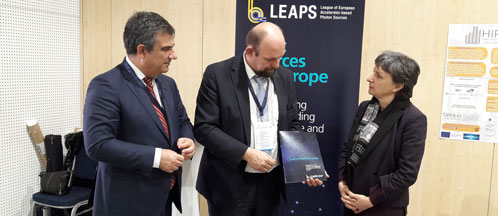ALBA Synchrotron

Director Jean-David Malo, DG Research and Innovation of the European Commission, received the strategy today at the Bulgarian Presidency Flagship Conference on Research Infrastructures.

Jean-David Malo, DG Research and Innovation of the European Commission, and Caterina Biscari, director of ALBA and Vice Chair of LEAPS. Picture: Mirjam van Daalen | Sofia - Bulgaria, 22nd March 2018. "I believe science makes the world a better place and I'm very happy to be able to present this strategy today", said Caterina Biscari, director of ALBA and Vice Chair of LEAPS. "I'm convinced it will be a major contribution in how to develop European research infrastructures in a cost-effective and sustainable way. I look forward to the upcoming discussions with the European Commission, with our national funders and with our extensive user community on how we, by joining forces, can boost European science and innovation". "By bringing together the community of national and pan European synchrotrons and free electron lasers facilities, the LEAPS initiative should be encouraged as it aims at structuring the European landscape of Research Infrastructures, coordinating strategic investments and facilitating transnational access", said Jean-David Malo, DG Research and Innovation of the European Commission. The health, prosperity, and security of European citizens today and in the future depend on meeting increasingly demanding challenges. These can be found in energy and transport, health care and food safety, and sustainable living. This demands new technology, new treatments and a better understanding of the world around us, all of which point to an increased role and reliance on highly sophisticated analytical tools like accelerator-based light sources to provide the most incisive means of measuring and unravelling atomic and molecular structures of the world around us. Europe hosts 13 synchrotron radiation facilities and six free electron laser facilities which all of them are founding members of LEAPS. They represent a multi-billion Euro investment with an annual operation budget of €700M serving more than 24 000 direct users. |
The LEAPS Strategy 2030 shows how the members, by joining forces, will be able to deliver even better capacity and capabilities at their research infrastructures. This will be done through smart specialisation, closer co-operation, better engagement with industry and working together with the existing user communities to reach out to scientists, academic and non-academic, that may not yet know of all the tools and skills available at photon sources for solving questions from all fields of science. The strategy explains how LEAPS will address key issues of the European Long-Term Sustainability Action Plan, presents roadmaps to optimise national and European resources and also describes the how the path towards FP9 looks with a few carefully selected pilot activities under the Horizon2020 programme.
"LEAPS fully embrace the European Commission's “Open Innovation, Open Science, Open to the World” concept and with the planned activities building on our strategy we hope to make a substantial contribution in making this a reality", concludes Caterina Biscari.
The LEAPS members are: ALBA, DESY, Diamond Light Source, Elettra, ESRF, European XFEL, Felix, HZB, HZDR, INFN, ISA, MAX IV, PSI, PTB, Solaris, Soleil.


At the left, intervention of Caterina Biscari, Director of the ALBA Synchrotron and Vice Chair of LEAPS, at the Conference on Research Infrastructures in Bulgaria. At the right, Caterina Biscari, presented the LEAPS Strategy 2030 to Jean-David Malo, Director, Directorate General Research and Innovation, European Commission.